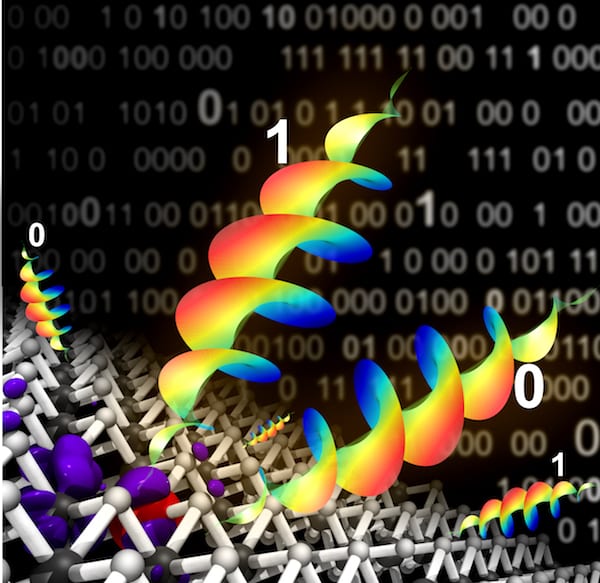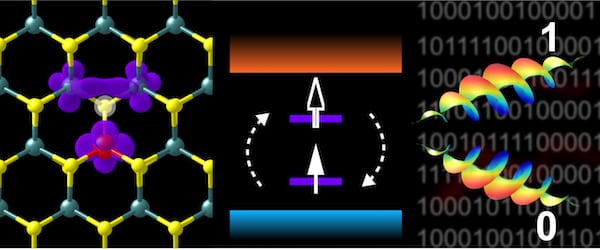Rice scientists show how atom-flat materials could produce polarized photons on demand
If you can make a single photon, tell it how to spin and tell it where to go, you have a basic element for next-generation computers that work with light instead of wires.
That appears to be possible with atom-thick materials, as demonstrated by several labs. Now, Rice University scientists have developed an understanding of the mechanism by which two-dimensional materials can be manipulated to produce the desired photons.

Defects in exotic, two-dimensional materials known as transition-metal dichalcogenides may be just what scientists need to advance quantum computing. Theoretical models by scientists at Rice University have predicted how particular 2D materials could be modified to produce photons with custom polarization. Illustration by Sunny Gupta
The Rice lab of materials theorist Boris Yakobson reported this month that by adding pre-arranged imperfections to atom-thick materials like molybdenum disulfide, they become perfectly capable of emitting single photons in either left or right polarization on demand.
The discovery through first-principle simulations is detailed in the American Chemical Society journal Nano Letters.
The photons come from designer defects in the 2D lattice that add their own peculiar electronic properties to semiconducting materials. In the case of molybdenum disulfide – their best candidate so far – a dash of rhenium in just the right spot makes a configuration of atoms with energy states that sit comfortably inside and are isolated from the material’s natural band gap.
Once in place, the magnetic moments of atoms in the defect can be aligned with a polarized magnet. Exciting them with light brings them to a higher energetic state, but the band gap is large enough that the energy has only one way to go: out, as a coveted single photon.
“Atoms that make up the defect have magnetic moments that can be random, but a magnetic field can bring them to a particular quantum state, either up or down,” Yakobson said. “After that, if you shine light on the defect, it goes from its ground state to an excited state and emits a desirable single photon, with specific polarization. That makes it a bit, which will be useful in quantum information processing.”
“The defect’s optical transition lies in the optical fiber telecommunication band, which is ideal for integration into photonic circuits,” added Rice graduate student and lead author Sunny Gupta.
All of the 2D candidates modeled by Yakobson, Gupta and alumnus Ji-Hui Yang are dichalcogenides, semiconductors that incorporate transition metals and chalcogens. They also modeled tungsten diselenide, zirconium disulfide, boron nitride, tungsten disufide, diamane (2D diamond, which labs are beginning to synthesize) and, for comparison, 3D diamond.

The defect creates a two-level energy state isolated from the semiconducting material’s natural band gap. Illustration by Sunny Gupta
“One of the advantages we argue here relative to 3D materials is that extraction of the photon is much easier, because the material is basically transparent and there is so little thickness,” Yakobson said. “Photons are not so easy to extract from 3D materials, because they may get stopped by internal reflections, or be refracted, or just dissipate in the material. But 2D materials are more open and the photon is produced near the surface, making its extraction for utility easier.”
Where that photon goes, nobody knows just yet. “We know the material can produce a photon of well-defined polarization and energy, and we suspect for good reasons that its direction is also well-defined, yet only probabilistically,” Yakobson said. “But we don’t want to go too far with the theories before somebody tries to make it in the lab.”
The Army Research Office and the Officeof Naval Research supported the research. Supercomputing resources were provided by the National Science Foundation-supported DAVinCI cluster at Rice, administered by the Center for Research Computing and procured in partnership with Rice’s Ken Kennedy Institute for Information Technology, the Department of Defense High Performance Computing Modernization Program and the Department of Energy Office of Science-supported National Energy Research Scientific Computing Center.

